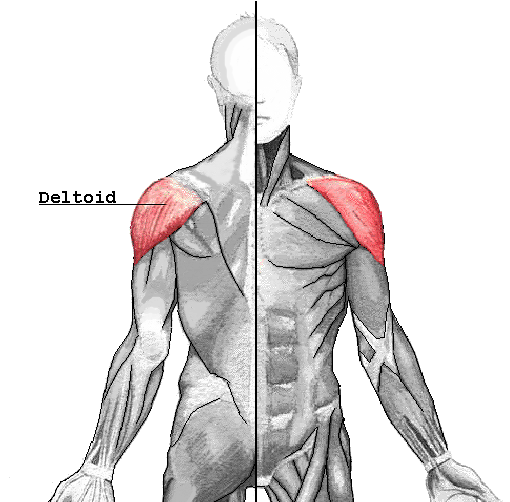The deltoid muscle is a thick muscle that covers the shoulder. Separated into three parts the front of the deltoid muscle flexes the arm and rotates it internally.
The middle of the deltoid muscle abducts or pulls the arm away from the side of the body, and the back of the deltoid muscle extends and laterally rotates the arm.
The deltoid muscle is extremely powerful and recruited for all types of athletic endeavors.
The front portion of the deltoid muscle has its origin on the outer third of the clavicle, the middle portion attaches to the acromion process, the jutting tip of the shoulder blade, and the back section of the deltoid connects to the spine of the shoulder blade. The other end of the deltoid muscle inserts in the middle of the outer arm bone at the deltoid tuberosity.
The main actions of the deltoid muscle are pulling that arm away from the body where it interacts with the supraspinatus muscle of the rotator cuff, and lifting the arm out in front of the body.
One of the functions of the rotator cuff is to keep the top of the arm bone (humerus) plugged in to the shoulder socket.
The contraction of the supraspinatus muscle begins to pull the arm away from the body. In anatomy terms these movements are broken down in degrees and the supraspinatus is the main muscle of abduction (pulling the arm away) for the first fifteen degrees of movement and then after thirty degrees the deltoid muscle takes over and is responsible for the rest of the action.
The deltoids work with and against a whole host of other muscles depending on the plane of the body that it moves within.
Moving the arm forwards, backwards or rotating it will always bring the deltoid into play along with muscles such as pectoralis major, latissimus dorsi and the other three rotator cuff muscles, supraspinatus, infraspinatus and teres minor.
Deltoid muscle injuries can be tricky as many shoulder injuries can seem like a deltoid strain.
The two structures that tend to get injured and mixed up with the deltoid muscle most often are the supraspinatus that I mentioned above and the long head tendon of the biceps which also helps to keep the arm bone in its socket.
Deltoid muscle injuries are often felt in the front of the shoulder and when lifting the arm away from the body to the front.
You might also have an injury in the muscle when lifting the arm away from the body to the side but it can be hard to make a distinction between the deltoid muscle and the supraspinatus.
Shoulder injuries can be tough—tough luck to get them, tough to diagnose and tough to heal because of how difficult it is to rest the shoulder which doesn’t often get a break in life.



